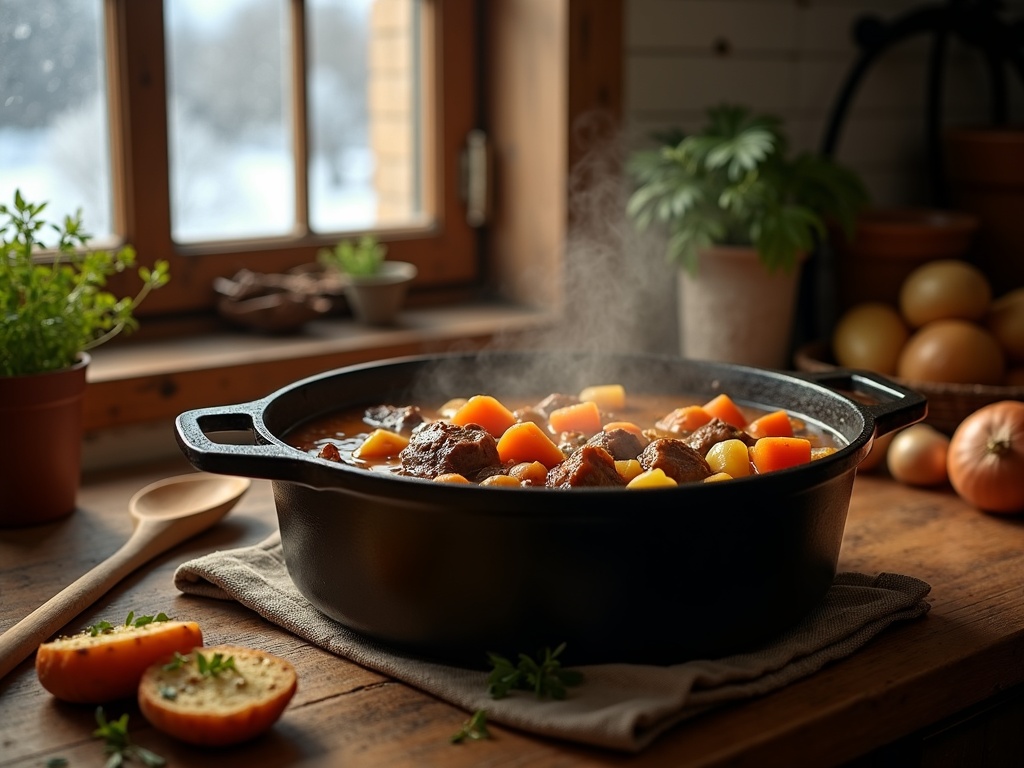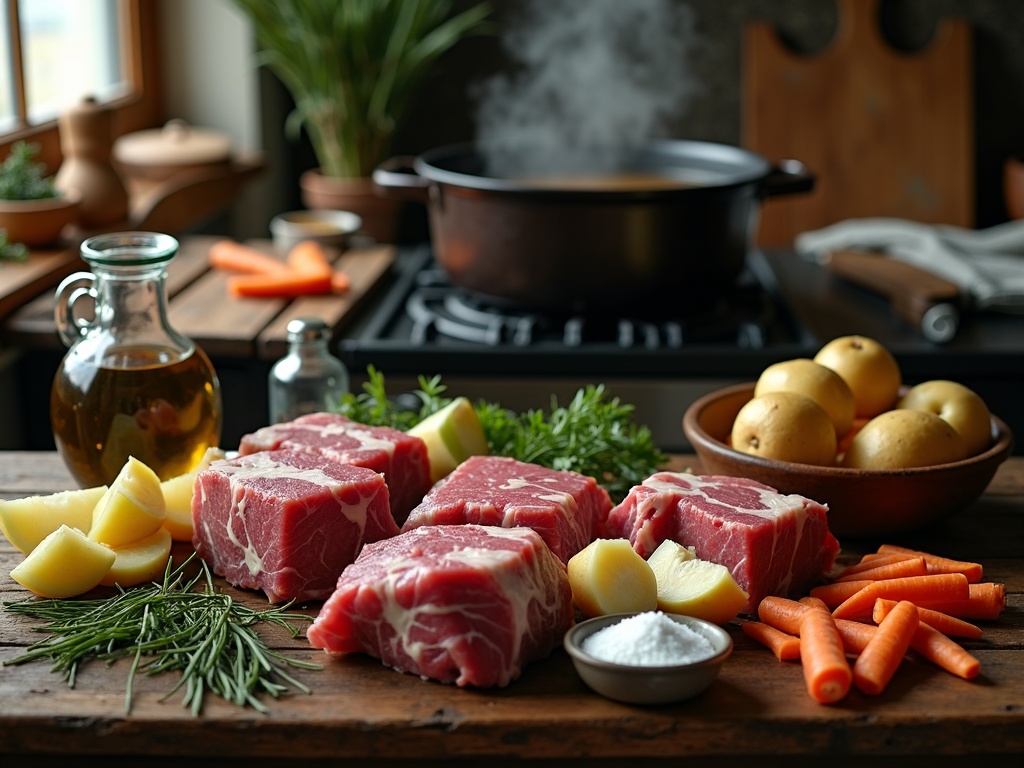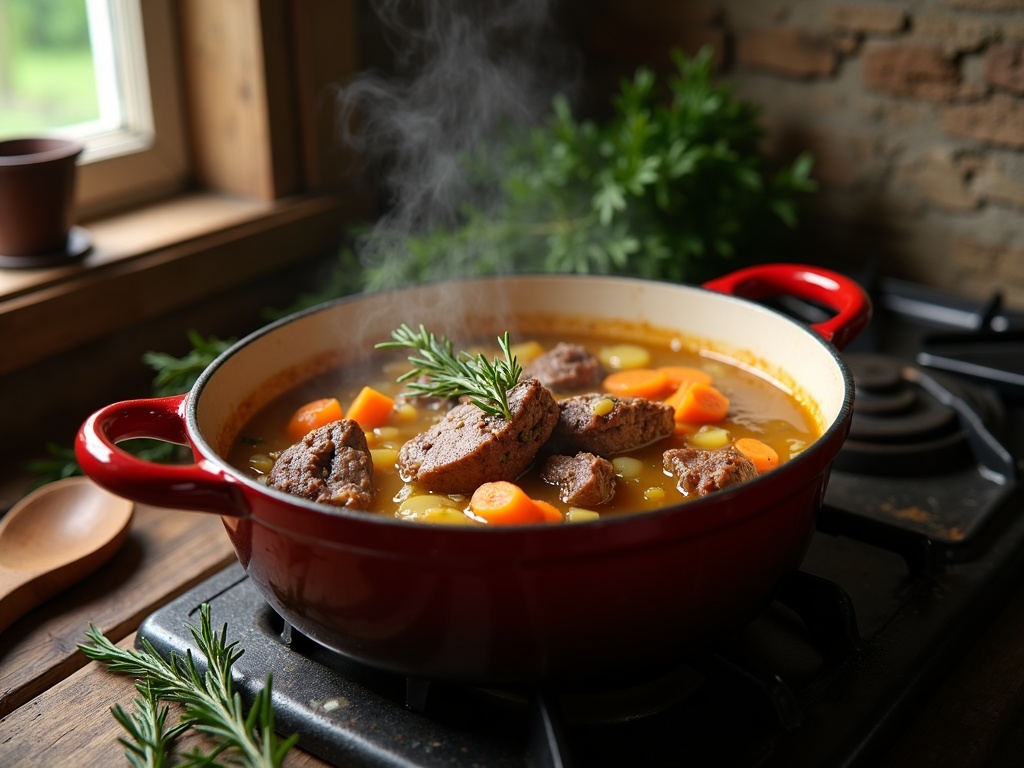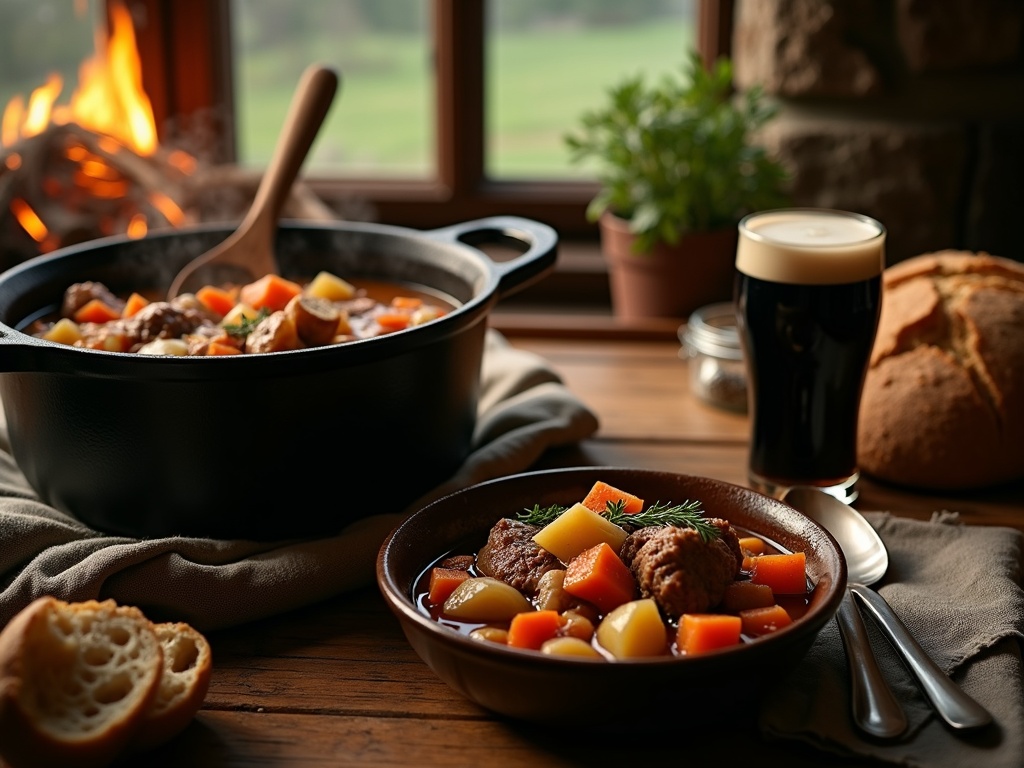Irish stew recipe stands as a cornerstone of traditional Irish cuisine, combining lamb or beef with vegetables in a slow-simmered, hearty broth that develops rich flavors during its lengthy cooking process. This one-pot meal transforms simple ingredients into an extraordinary comfort food that actually tastes even better when reheated the next day, making it ideal for meal planning and family dinners.
Table of Contents
Key Takeaways
- The best Irish stew uses fatty cuts like lamb shoulder that break down during slow cooking to create a naturally rich gravy.
- Browning meat in batches and layering ingredients are crucial techniques for developing deep flavor.
- The dish requires patience with a minimum 2–3 hour simmer time to achieve the perfect melt-in-your-mouth texture.
- Vegetables should be cut into large, uniform chunks (about 1 inch) to prevent them from disintegrating during long cooking.
- Irish stew freezes exceptionally well for up to 3 months and often tastes better the next day as flavors continue to develop.
Why This Recipe Works
I’ve found this Irish stew recipe to be a lifesaver during the coldest months of the year. It’s a hearty one-pot meal that combines simplicity with incredible depth of flavor. The beauty lies in how basic ingredients transform into something extraordinary through a slow cooking process that allows flavors to meld perfectly.
Perfect Comfort Food Chemistry
The magic happens when tender chunks of meat slowly release their juices into the cooking liquid, creating a naturally rich gravy without any fancy techniques. Each bite delivers melt-in-your-mouth meat alongside vegetables that have absorbed all those savory flavors. This stew strikes the perfect balance of hearty substance and comforting warmth.
What makes this recipe particularly special is the way it combines just a handful of ingredients – typically meat, potatoes, onions, carrots, and a few basic seasonings. Yet through the gentle simmering process, these components develop a complexity that tastes like you spent hours crafting a complicated dish. The potatoes serve double duty by both retaining their shape and partially breaking down to thicken the gravy naturally.
Practical Benefits Beyond Flavor
Beyond just tasting delicious, this traditional Irish comfort food offers practical advantages that make it worth adding to your regular meal rotation:
- The flavors actually improve overnight, making it perfect for meal prep
- It freezes exceptionally well for up to 3 months
- One batch can provide multiple meals for a family
- It’s adaptable to what you have on hand (beef works if you can’t find lamb)
- Requires minimal active cooking time despite the long simmer
I’ve found this stew pairs wonderfully with crusty bread or even alongside classic corned beef for a true Irish feast. The recipe can be adapted for various cooking methods too – stovetop, slow cooker, or even pressure cooker for busier days.
What truly sets a great Irish stew apart is patience. The longer it simmers, the more the meat becomes tender and the flavors develop. This isn’t a quick weeknight meal but rather a Sunday afternoon project that rewards you with leftovers that taste even better throughout the week.

Essential Ingredients You’ll Need
Traditional Irish stew has stood the test of time because of its simple yet hearty ingredients. I’ve found that using high-quality components makes all the difference in creating an authentic and flavorful dish that warms you from the inside out.
The Core Components
At the heart of any proper Irish stew is tender, flavorful meat. You’ll need 2 pounds of lamb shoulder cut into chunks. Lamb shoulder is perfect for this recipe because it has just the right amount of fat that melts during cooking, creating a rich and velvety sauce. If you enjoy other meat dishes, you might also like these venison recipes for dinner as an alternative game meat option.
The vegetables form the backbone of this rustic dish. Gather:
- 6 medium potatoes, quartered (leaving the skins on adds texture and nutrition)
- 4 large carrots, roughly chopped into chunky pieces
- 2 onions, sliced into half-moons
These vegetables not only add flavor but also absorb the savory broth as they cook.
For the liquid base, you’ll need 4 cups of beef broth. This provides a deeper flavor than using water alone. The rich beef flavor complements the lamb beautifully, similar to how it works in a traditional cottage pie recipe with its savory gravy.
Fresh herbs truly elevate this dish from good to exceptional. Several sprigs of fresh thyme will infuse the stew with earthy aromatics as it simmers. For serving, keep some fresh parsley on hand to brighten up each bowl with a sprinkle of green.
Don’t forget your seasonings — salt and black pepper are essential for bringing out all the natural flavors. The beauty of Irish stew is in its simplicity, so there’s no need for complex spice blends.
You’ll also need 2 tablespoons of vegetable oil for browning the meat, which is a crucial step for developing deep flavor. This same technique is used in many beef dishes, including ground beef recipes that benefit from proper browning.
The ingredients list might seem basic, but that’s the beauty of Irish stew. It’s a prime example of how humble ingredients can transform into something truly special when given time to simmer together. The lamb becomes fork-tender, the potatoes slightly break down to thicken the broth, and the carrots and onions add sweetness and depth.
For those who enjoy exploring traditional meat and vegetable combinations, you might also appreciate learning how to make corned beef and sauerkraut in oven for another classic comfort food option.
What makes this recipe so appealing is that it requires minimal prep work — just some basic chopping and slicing. The stove (or slow cooker) does most of the work, allowing all these simple ingredients to meld together into a cohesive, soul-satisfying meal that’s greater than the sum of its parts.
This ingredient list showcases why Irish stew has remained popular for generations — it’s made with accessible, affordable ingredients that come together to create something truly special. Whether you’re cooking for St. Patrick’s Day or just craving comfort food on a cold evening, these essential components will help you create an authentic taste of Ireland in your own kitchen.

How to Make Perfect Irish Stew
Creating an authentic Irish stew doesn’t have to be complicated. I’ve refined my technique over years to deliver that warm, comforting flavor that makes this classic dish so beloved. The key lies in respecting each ingredient and giving them the proper treatment.
My Step-by-Step Method
I always start by properly seasoning and browning my meat in batches. This crucial first step creates a foundation of flavor that can’t be achieved any other way. Using lamb or beef chunks (traditionally lamb is more authentic), I season them generously with salt and pepper, then brown them in hot oil in small batches. Crowding the pan is a mistake that prevents proper caramelization, so taking my time here pays off tremendously in the final dish.
Next, I sauté the onions in the same pot until they reach a beautiful golden color. This process, which takes about 5–7 minutes, releases their natural sweetness and adds depth to the stew. The onions absorb all those delicious browned bits from the meat, creating an incredible flavor base.
The layering technique truly distinguishes a great Irish stew from an average one. I place the vegetables and meat in alternating layers in my heavy pot. This traditional approach ensures even cooking and flavor distribution. My typical arrangement includes:
- A base layer of onions
- Browned meat chunks spread evenly
- Sliced carrots and potatoes on top
- Another layer of meat if needed
- Final layer of potatoes to create a nice crust
After layering, I add enough hearty beef or lamb broth to just barely cover the ingredients. I’m careful not to add too much liquid as the vegetables release moisture during cooking. For authentic flavor, I add fresh thyme, a bay leaf, and sometimes a sprig of rosemary.
The final and most important step is the slow simmer. I bring the stew to a gentle boil, then reduce to a bare simmer, cover, and let it cook for about 2 hours. This patience transforms tough meat into tender morsels and allows all the flavors to meld beautifully. I occasionally check to ensure there’s enough liquid, adding a splash more broth if needed.
This approach consistently delivers a comfort food masterpiece that rivals any I’ve tasted in Ireland. The meat becomes fall-apart tender, the vegetables soft but not mushy, and the broth rich and satisfying.

Common Mistakes to Avoid
I’ve cooked my fair share of Irish stews over the years, and I’ve learned that this seemingly simple dish can go wrong in surprisingly many ways. Avoiding a few common pitfalls can make the difference between a mediocre meal and a memorable one that honors this classic Irish tradition.
Critical Errors That Ruin Your Irish Stew
Rushing the cooking process is perhaps the most frequent mistake home cooks make when preparing Irish stew. This dish depends on slow cooking to develop its rich flavors and allow the meat to become tender. I’ve found that at least 2–3 hours of gentle simmering is necessary for the flavors to meld properly and for the meat to reach that perfect fall-apart texture. Trying to speed things up by increasing the heat only results in tough meat and underdeveloped flavor.
Using lean meat cuts is another error that can dramatically affect your stew’s quality. Traditional Irish stew relies on fattier, tougher cuts like lamb shoulder or beef chuck that break down during long cooking. These cuts contain connective tissue that melts into the broth, creating richness and body. When you opt for leaner cuts like sirloin or tenderloin, you’ll end up with dry, chewy meat and a thin, flavorless broth. I always look for meat with good marbling for the best results.
Many cooks make the mistake of overcrowding the pot while browning the meat. When too many pieces are added at once, the temperature of the pan drops, and the meat steams rather than browns. This prevents the development of the flavorful crust that adds depth to your stew. I always brown my meat in small batches, giving each piece enough space to caramelize properly. This extra time investment pays off enormously in the final flavor of your traditional Irish dish.
Adding too much liquid is a subtle error that can dilute your stew’s flavor. While it might seem like you need to cover everything completely, the meat and vegetables will release their juices as they cook. I typically add just enough liquid to come about two-thirds of the way up the ingredients. As the stew simmers, the flavors concentrate, creating that signature rich broth that’s perfect for sopping up with hearty bread.
Cutting vegetables too small is particularly problematic in long-cooking dishes like Irish stew. When potatoes, carrots, and other vegetables are diced too finely, they disintegrate during the long cooking time, turning your stew into mush. I cut my vegetables into larger chunks—about 1–2 inches—so they maintain their integrity while still absorbing the flavors of the broth. This approach ensures you get distinct pieces of tender vegetables in each spoonful, similar to how they’re presented in a proper cottage pie.
I’ve noticed that seasoning only at the end is another common error. Irish stew benefits from layered seasoning throughout the cooking process. I season the meat before browning, add some salt when the vegetables go in, and then adjust the final seasoning toward the end of cooking. This approach builds flavor at every stage.
Forgetting the importance of the right pot can also impact your results. A heavy-bottomed Dutch oven or cast iron pot distributes heat evenly and retains it well, perfect for the slow-cooking needed for Irish stew. Using a thin pot can lead to hot spots and uneven cooking, potentially burning some areas while leaving others undercooked. This cooking method works equally well for other slow-cooked beef recipes that require similar patience and technique.
By avoiding these common mistakes, I’ve found that my Irish stew consistently turns out rich, flavorful, and authentically satisfying—a true comfort food worthy of its storied heritage.
Pro Tips for Best Results
Perfecting an Irish stew isn’t complicated, but a few crucial steps can transform your dish from good to outstanding. I’ve gathered some professional tips that’ll help you create the most flavorful and authentic Irish stew possible.
Selecting and Preparing Ingredients
Choose lamb shoulder or neck for your stew base. These cuts contain more connective tissue that breaks down during slow cooking, creating that melt-in-your-mouth texture that’s essential for a traditional Irish stew. The fat content in these cuts also adds richness to the broth that leaner cuts simply can’t provide.
Before cooking, let your meat reach room temperature by taking it out of the refrigerator 30–45 minutes before you plan to start. This simple step ensures even cooking and better browning, which leads to enhanced flavor development. Cold meat can seize up when it hits a hot pan, resulting in tough, chewy pieces rather than the tender morsels you’re aiming for.
When preparing vegetables, keep the chunks large and uniform in size. This isn’t just for appearance – it serves a practical purpose. Vegetables cut too small will disintegrate during the long cooking process, while uniformity ensures everything cooks at the same rate. I aim for roughly 1-inch chunks for potatoes, carrots and other root vegetables that maintain their structure throughout the cooking process. This approach gives your hearty potato dishes the perfect texture.
Enhancing Flavors and Textures
The foundation of any outstanding stew is its liquid base. While store-bought stock is convenient, using homemade stock dramatically improves your stew’s depth of flavor. If preparing your own, consider making it a day ahead and storing it in the refrigerator. This allows you to easily remove excess fat that solidifies at the top while concentrating the stock’s rich flavor.
For the most flavorful beef-based meals, homemade stock is unmatched, but the same principle applies to lamb stock for Irish stew. If homemade isn’t an option, look for low-sodium options at the store so you can control the salt level yourself.
One often overlooked step is letting the stew rest before serving. Just like with a roast or well-prepared corned beef, giving your stew 15–20 minutes off the heat before serving allows flavors to meld and intensify. During this resting period, the stew continues to develop depth while cooling to a more enjoyable eating temperature.
The patience required for this final step pays off tremendously in the final product. I’ve found that stews served immediately after cooking don’t compare to those that have had time to rest. This short waiting period allows all those complex flavors to settle and harmonize, creating that distinctive taste that makes Irish stew so addictive.
For maximum flavor, consider making your stew a day ahead and reheating it gently before serving. Like many game meat recipes, Irish stew often tastes even better the next day when the flavors have had ample time to develop and combine. This make-ahead approach isn’t just convenient for entertaining; it genuinely improves the eating experience.
These tips might seem minor individually, but together they make all the difference between an average stew and an exceptional one that captures the true essence of this classic Irish comfort food.
Serving Suggestions
After preparing a hearty Irish stew, I’ve found that the right accompaniments can elevate this classic dish to new heights. The rich, savory flavors of the stew pair beautifully with several traditional sides and beverages that complement rather than compete with the main attraction.
Traditional Bread Pairings
Nothing absorbs the delicious gravy of an Irish stew better than proper bread. Fresh crusty bread with a thick, crunchy crust and soft interior makes an ideal vehicle for soaking up every last bit of flavor. I often tear off chunks rather than slice it, creating perfect rustic pieces for dipping.
Traditional Irish comfort foods like stew are incomplete without authentic Irish soda bread. This quick bread’s dense texture and mild flavor create the perfect balance with the stew’s richness. The slight tanginess from buttermilk in the bread cuts through the savory meat and vegetables beautifully.
Complementary Sides and Finishing Touches
A simple green salad provides a fresh, crisp contrast to the hearty stew. I prefer a light vinaigrette dressing that won’t overpower the meal—just enough acidity to cleanse the palate between bites of the rich main course.
For an authentic Irish dining experience, serve the stew with a glass of Guinness. The dark stout’s roasted, malty flavors mirror and enhance similar notes in the stew. The robust flavors of Irish cuisine pair perfectly with this iconic beverage.
Just before serving, I sprinkle fresh herbs over the stew for color and aroma. Chopped parsley adds vibrant green flecks and a fresh flavor note, while thyme or rosemary echo herbs used in the cooking process. This simple garnish transforms the appearance of the dish and adds a final layer of flavor complexity.
For a complete meal experience, consider these additional serving ideas:
- Mashed potatoes (if not already in the stew)
- Roasted root vegetables as a side
- Pickled red cabbage for acidity and color
- Horseradish cream for a spicy kick
- Alternative protein recipes for those wanting smaller portions of stew
Storage and Reheating
I’ve found that proper storage and reheating techniques can make all the difference in preserving the delicious flavors of Irish stew. This hearty dish actually improves with time as the flavors continue to meld together, making it perfect for meal prep or leftovers.
Proper Storage Methods
After preparing your Irish stew, let it cool completely before transferring it to airtight containers. When stored properly in the refrigerator, the stew keeps well for 3–4 days, making it perfect for enjoying throughout the week. For longer storage, freezing is an excellent option—portion the stew into freezer-safe containers, leaving about an inch of headspace to allow for expansion. It can be frozen for up to 3 months without significant loss of quality or flavor.
If you enjoy making hearty meat-based dishes like Irish stew, you’ll appreciate how well they store compared to more delicate meals.
Reheating Tips for Best Results
When it’s time to enjoy your stored stew, I recommend reheating it slowly on the stovetop over medium-low heat. This gentle approach prevents the meats from becoming tough and the vegetables from turning mushy. During reheating, you might find the stew has thickened considerably—don’t hesitate to add a splash of broth to restore the original consistency.
One of the most important tips I can share is to stir gently during reheating to avoid breaking the tender vegetables. This is especially true if your stew contains potatoes, which can become soft and fragile after storage.
The reheating process is also a good opportunity to check and adjust seasonings, as flavors can intensify during storage. For an extra touch of freshness, consider adding a sprinkle of chopped parsley just before serving your reheated beef-based recipe.
Similar to traditional corned beef dishes, Irish stew develops deeper flavors after a day in the refrigerator, making leftovers sometimes even more delicious than the fresh batch!

